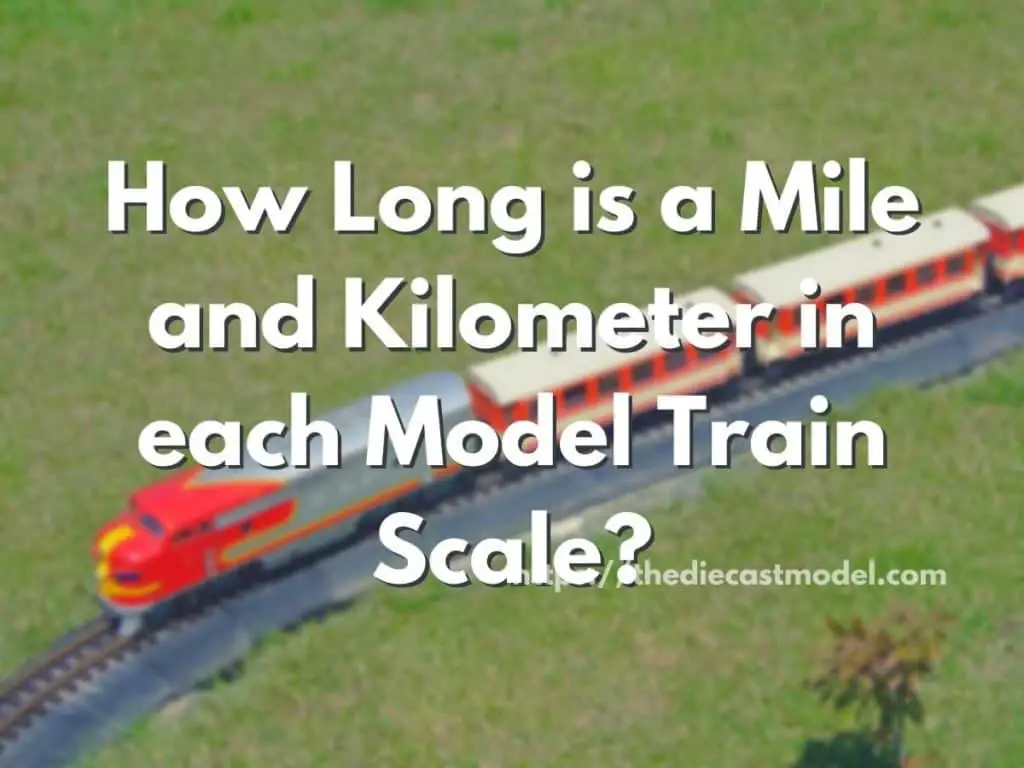How Long is a Mile and Kilometer in each Model Train Scale?
When designing your layout, it might be good to know how long a mile or kilometer is on each scale. This allows you to plan on what to put, how long your tracks will be, and the size of your accessories, such as the cars, mountains, trees, rocks, and buildings. This post will serve as your guide on the length of tracks for each scale per mile or kilometer.
| Scale | Feet per Mile | Meters per Mile | Feet per Kilometer | Meters per Kilometer |
| HO Scale | 60ft | 18.3m | 37.5ft | 11.40m |
| OO Scale | 60ft | 18.3m | 37.5ft | 11.40m |
| N Scale | 32.75ft | 10m | 20.5ft | 6.25m |
| O Scale | 115.5ft | 35.2m | 72.20ft | 22m |
| G Scale | 163.6ft | 50m | 102.25ft | 31.15m |
| F Scale | 256.75ft | 78.25m | 160.50ft | 49m |
| S Scale | 85ft | 26m | 51ft | 15.5m |
| Z Scale | 23.5ft | 7.2m | 14.8ft | 4.5m |
| T Scale | 11ft | 3.4m | 6.8ft | 2.1m |
| TT Scale | 43.5ft | 13.25m | 27.25ft | 8.3m |
This post will revolve around the table above. How to interpret and how I came up with these values. Furthermore, I will also explain the common scales such as HO, N, and O scales.

How to Interpret the Data on the Table
The table above can be intimidating as there are a lot of data points.
So, here is a simple guide on how to use the table.
Let’s say we want to find out how long is an actual mile on the HO scale.
Looking at the data, we need to look at the “HO” and then the “feet per mile” category.
Using the data, we can see “60ft”.
Now, let’s combine all of these data.
A 60ft HO scale layout would be equivalent to a mile in actual life.
That is the same for kilometers for the HO scale.
Looking at the data, we need to look at the “HO” and then the “feet per kilometer” category.
Using the data, we can see “37.5ft”.
A 37.5ft HO scale layout would be equivalent to a kilometer in actual life.
Let’s try one more example.
Let’s find how many feet on the N scale are equivalent to a mile.
Looking at the data, we need to look at the “N” and then the “feet per mile” category.
Using the data, we can see “32.75ft”.
A 32.75ft N scale layout would be equivalent to a mile in actual life.
Right now, if the scale you have isn’t in the table, I will teach you how to compute and convert a scale to an actual mile or kilometer.
That’s our topic for the next section.
How to Compute Actual distance to Scale
Let’s now compute the actual distance to scale, which I used to come up with the data.
Let’s try computing for HO.
The first thing you need to find out is the scale. In this case, the HO scale is equivalent to 1:87.
Here is a table summary of the model train scales and their actual scale.
| Scale | Actual Scale |
| HO | 1:87 |
| OO | 1:76 |
| N | 1:148, 1:160 |
| O | 1:48 |
| G | 1:22.5, 1:24, 1:25,1:29, 1:32 |
| F | 1:20.3 |
| S | 1:64 |
| Z | 1:220 |
| T | 1:450, 1:480 |
| TT | 1:120 |
For now, let’s use the HO scale. As we can see, it is 1:87.
To scale a mile or kilometer, we have to divide the actual distance by the scale.
For example, a mile is 5280ft. Thus, if we divide 5280 by 87, we will get about 60.6ft.
5280/87=60.6ft
To keep it simple, I placed 60ft on the table.
This means a 60ft HO scale layout will be equivalent to a mile if converted to real-life size.
However, while this method is very simple, it has a big drawback.
One of the drawbacks we can see from above is that while the OO scale is 1/76, we can see that their size is the same as the HO, which is 1/87.
Furthermore, other scales, such as the G scale, use a variety of scales such as 1:22.5, 1:24, 1:25,1:29, and 1:32.
In these cases, the formula above wouldn’t work.
This content was originally posted on thediecastmodel.com. If it appears on other websites, it is a violation of the copyright owned by thediecastmodel.com.
Another example is the N scale which can be 1:148 and 1:160. Which one should we use then?
The truth is, while the computation of scale to actual distance is as easy as dividing, it has these drawbacks.
That’s why in model railroading, we use the gauge since it will provide a more accurate result.
Here are the gauges of each scale.
| Scale | Standard Gauge Width |
| HO | 16.5mm |
| OO | 16.5mm |
| N | 9mm |
| O | 31.75mm |
| G | 45mm |
| F | 70.6mm |
| S | 22.5mm |
| Z | 6.5mm |
| T | 3mm |
| TT | 12mm |
But what is the gauge? Gauge is simply the distance between rails.
All scales have their standard gauge size, which we could use to get the miles.
Since we have seen the limitations of using scales for the G, N, and OO scales, let’s use them as an example.
Here are the formulas:
- To compute for miles: (standard gauge/16.5)*60
- To compute for kilometers: (standard gauge/16.5)*37.5
First, let’s talk about where the 16.5, 60, and 37.5 came from.
16.5 comes from the gauge of the HO scale, which is 16.5mm, and 60 comes from 60ft which is the size of an HO scale converted to a mile.
Whereas 37.5 came from 37.5ft which is the size of an HO scale when converted to kilometers.
I made the formula for simplicity, but you can use other scales.
Now, let’s use the formula, shall we?
Let’s start with OO. As you can see, their gauge is the same as HO, which is 16.5mm. Thus, all OO scale trains can run on HO tracks and vice versa.
(16.5/16.5)*60 = 60ft
So, a 60ft OO scale layout is equivalent to a mile.
Now, let’s try km since the OO scale is popular in the UK.
(16.5/16.5)*37.5 = 37.5ft
So, a 37.5ft OO scale layout is equivalent to a kilometer.
Let’s try the N scale. Instead of using the scales, we will use the gauge.
For miles:
(45/16.5)*60 = 32.75ft
For kilometers:
(45/16.5)*37.5 = 20.5ft
So, a 32.75ft N scale layout is equivalent to a mile in real life, and a 20.5ft N scale layout is equal to a kilometer in real life.
Now, let’s try the confusing G scale.
Instead of using their scales which are 1:22.5, 1:24, 1:25,1:29, and 1:32, let’s use the gauge.
For miles:
(9/16.5)*60 = 163.6ft
For kilometers:
(9/16.5)*37.5 = 102.25ft
So, a 163.6ft G scale layout is equivalent to a mile in real life, and a 102.25ft G scale layout is equal to a kilometer in real life.
Easy, right?
Recommended Read: Are you interested in increasing the power output of your train motor so it can pull more cars? If you are interested, feel free to check this post: How many cars can a model train locomotive pull?
Frequently Asked Questions:
How long is a mile or kilometer on the N scale?
A 32.75ft long N scale layout is equivalent to a mile, and a 20.5ft long N scale layout equals a kilometer.
How long is a mile or kilometer on the HO scale?
A 60ft long HO scale layout is equivalent to a mile, and a 37.5ft long HO scale layout is equal to a kilometer.
How long is a mile or kilometer on the O scale?
A 115.5ft long HO scale layout is equivalent to a mile, and a 72.20ft long HO scale layout is equal to a kilometer.
What’s next: If you want a comprehensive differentiation of all the train model scales, feel free to check this post: Difference Scale Model Trains.







